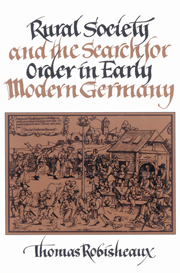Book contents
- Frontmatter
- Contents
- List of illustrations and tables
- Acknowledgments
- A note on usages
- Glossary
- List of abbreviations
- Introduction
- Part One Agrarian expansion, revolt, and the decay of community
- Part Two Search for order
- Part Three Crisis and recovery
- Appendix A Distribution of wealth in Langenburg district, 1528–1581
- Appendix B Grain production and the peasant household
- Manuscript sources
- Bibliographical essay
- Index
Appendix B - Grain production and the peasant household
Published online by Cambridge University Press: 05 May 2010
- Frontmatter
- Contents
- List of illustrations and tables
- Acknowledgments
- A note on usages
- Glossary
- List of abbreviations
- Introduction
- Part One Agrarian expansion, revolt, and the decay of community
- Part Two Search for order
- Part Three Crisis and recovery
- Appendix A Distribution of wealth in Langenburg district, 1528–1581
- Appendix B Grain production and the peasant household
- Manuscript sources
- Bibliographical essay
- Index
Summary
In order to understand the agrarian cycle and the great advance and fall of population that lay behind it, one must have a firm understanding of the productivity of the peasant household. Only with precise statistical data can one answer the pivotal questions that present themselves for any study of the sixteenth and seventeenth centuries. How much surplus grain could the rural economy actually produce? When did marginal returns on the land begin to set in, and in which parts of the countryside? Which households produced enough grain to feed its dependents, and which could not? As I point out in Chapters 6, 7, and 8, answers to these questions help us not simply to understand agricultural productivity, they guide us to other key issues in the making of the social hierarchy in the village as well. For one of the key functions of hierarchy in this society was control over the distribution of land, scarce material goods, and food. How villagers understood the polarization that took place in village society between wealthy and poor, the role food supplies and land scarcity played in conflict, the ability of villagers to pay taxes, and even popular attitudes toward state authority were all conditioned, to some degree, by access to land and agricultural productivity. Every study of these problems should therefore have a precise understanding of who controlled and produced such resources, and how far these resources met the material needs of the peasant household.
- Type
- Chapter
- Information
- Rural Society and the Search for Order in Early Modern Germany , pp. 266 - 268Publisher: Cambridge University PressPrint publication year: 1989



